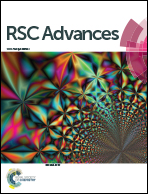A highly transparent humidity sensor with fast response speed based on α-MoO3 thin films†
Abstract
Metal oxide based humidity sensors are important indicators in environmental monitoring. However, most of them are non-transparent and have a long response time, which cannot meet the application of real-time humidity sensing in transparent electronics. Here, we report a metal oxide humidity sensor based on chemically synthesized molybdenum oxide (α-MoO3) thin films. By a green reaction in an ice water bath, the stable precursor containing nanocrystalline colloids was obtained. Molybdenum oxide films with controllable morphology were fabricated through one-step spin coating. The α-MoO3 based humidity sensor exhibits extremely high transparency (85%) in the visible region and has short response and recovery times (0.97 and 12.11 s). In addition, it also shows high sensitivity, good logarithmic linearity and selectivity in a wide relative humidity range of 11% to 95%. The mechanism of humidity sensing was further studied by complex impedance spectroscopy. This novel metal oxide humidity sensor combined with high transparency and fast response speed is expected to broaden the application ranges of humidity sensors.



 Please wait while we load your content...
Please wait while we load your content...